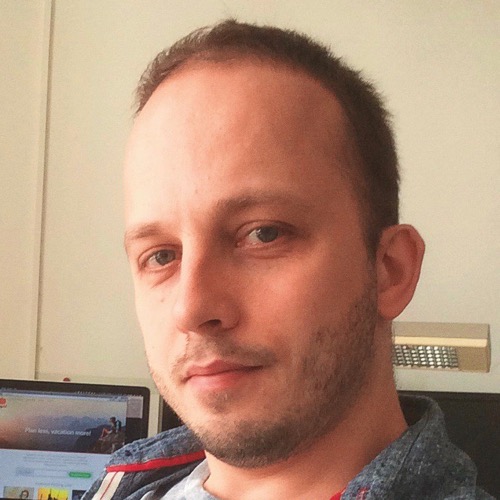Dynamic decomposition of the wave-field and reconstruction of the media
06/2002–09/2005
Responsible for design and implementation.
Dynamic decomposition of the wave-field and reconstruction of the media (DDR) - method of VSP seismic data processing and interpretation.
Introduction
As a rule, the processing and interpretation of seismic data are divided in time and often are carried out by the different software packages. Thus the information about model is used not in complete volume, and some simplified approaches have to be applied.
Now most imaging procedures are based on ray-tracing and various migration transformations, but each of such methods separately has a number of serious disadvantages. Only parts of whole wave field, such as P or PS waves are used for imaging.
Besides in many cases strongly simplified models of environment (such as flat boundaries, absence of gradients of velocities etc.) are used which results in large errors in interpretation.
The first approach to the new technique of processing and interpretation of the VSP data in complex models consisting of adjacent system of arbitrary-non-uniform bodies with fragmentally regular borders is presented below.
The regular waves of various types and orders have to be consistently located and subtracted from an initial field and projected on the image with use of basic model. For subtraction the time graph and amplitudes calculated on initial model of environment are used within the framework of a ray-tracing method.
Obtained image can be used for correction of initial model, and this way is one of iterative steps to determine model which is adequate to interpreted wave field. Further we shall call this method as a method of Dynamic Decomposition and Reconstruction (DDR) (Tabakov et al., 2002).
DDR technology
The technology of VSP data processing by means of DDR technique consists of several procedures:
- Construction of the first approximation to model as a result of kinematical inversion of travel times and polarizations for visually correlated events in original data (Stepchenkov et al., 2005).
- The synthetic wave parameters are calculated by ray-tracing method for strongest event.
- The estimation of the form of a wave along calculated arrival times-graph with use of designed distribution of amplitudes and polarization is carried out.
- The located wave is subtracted from an initial field and is projected to points of scattering on the image with recalculation on factor of reflection of a P-wave on external perpendicular to border. The waves of various types from the same point of boundary are stacked with weights proportional to their original amplitude. The process is repeated for all types of waves and all boundaries until all regular events are subtracted and projected on section. Not only primary waves, but also multiples may used in the process.
After imaging the basic model can be corrected and the process may be repeated until the image will correspond to model with necessary accuracy (Reshetnikov et al., 2003). Fig. 1 shows the scheme of DDR technology.
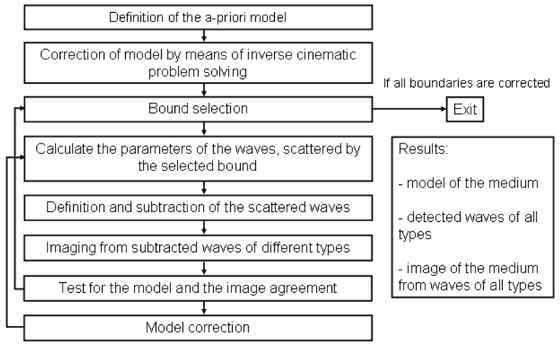
Figure 1. DDR method workflow.
Joint imaging of the media using different types of waves
Depending on boundaries configuration, different parts of interfaces can be exposed by one or more type of waves. Obviously, all types of waves contain information about properties of the media. It means that in process of imaging of the media all available information should be used. It is also necessary for the derived solution to particularly include "one-wave imaging" case.
The way to calculate joint image is summing of the images from all types of waves. It is important to remember that all images dynamically correspond to different physical measures. Therefore images must be normalized before stacking. Resulting measure can be selected as value of P-waves reflection coefficient along normal to the boundary. Then normalization coefficient can be evaluated as

where
K — reflection coefficient, calculated using reference model;
K0P — normalized measure;
N — number of summed images.
Thus, for all boundaries of the model joint images can be calculated using all types of waves. These images can be composed into one seismic section. In this section amplitudes correspond to the reflection characteristic of the media (Reshetnikov et al., 2004).
This method allows constructing of full seismic image which represents the media as values of true reflection coefficient along normal to the boundaries. Fig. 2 and 3 presents the images for different types of waves and joint image of the boundary.
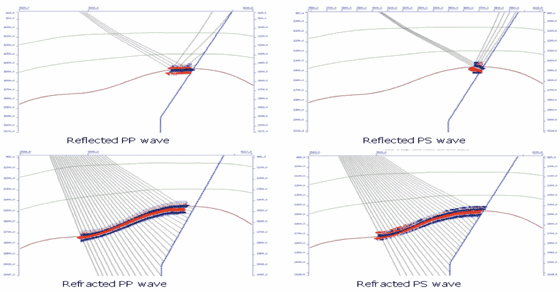
Figure 2. Images for different types of waves.
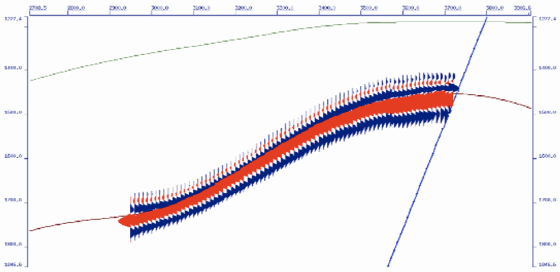
Figure 3. Joint image of the boundary.
Results
Numerical experiment was carried out to illustrate the proposed concept. Based on a given velocity model synthetic wave field was computed by finite-difference method (fig. 4). Then travel times of all primary reflected and transmitted waves were picked and depth marks of model interfaces were defined along the borehole (fig. 5). After that the procedure of kinematic inversion was implemented. The derived velocity model then was adjusted with the use of DDR techniques. Comparison of the resulting recovered model and original model is displayed in fig. 6.
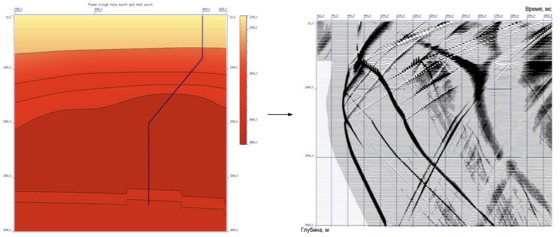
Figure 4. Given velocity model and synthetic wave field.
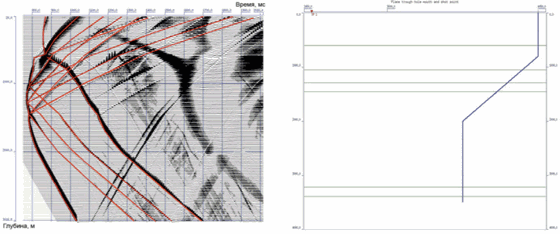
Figure 5. Travel times of all primary reflected and transmitted waves and model interfaces position on the borehole.
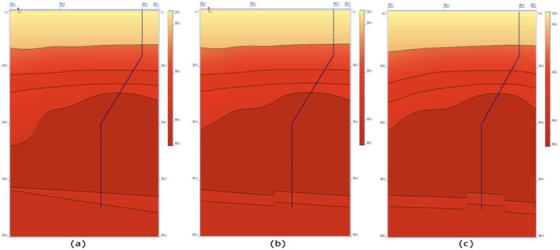
Figure 6. Result of inverse kinematic problem (a), resulting recovered model (b) and original model (c).
References
- Tabakov, A.A., Soltan, I.E., Reshetnikov, A.V.,Reshetnikov, V.V. 2002. Dynamic decomposition of the wave-field and reconstruction of the media in VSP data processing. 2th Conference and Exhibition "Gal'perin Readings", Moscow, Abstracts. 12-13. (published in Russian only).
- Reshetnikov, A.V., Reshetnikov, V.V., Soltan, I.E., Tabakov, A.A. 2003. Dynamic decomposition of seismic wavefields and media model reconstruction with raytracing method by VSP data.. International Conference and Exhibition "Geophysics of the XXI Century — Leap into the Future", Moscow, Expanded Abstracts.
- Reshetnikov, A.V., Stepchenkov, Yu.A., Tabakov, A.A., Eliseev V.L. 2004. Joint imaging of the media using different types of waves. 4th Conference and Exhibition "Gal'perin Readings", Moscow, Abstracts. 60-62. (published in Russian only).
- Stepchenkov, Yu.A., Tabakov, A.A., Reshetnikov, A.V. 2005. Estimation of the velocity model from full vector VSP wave field. 5th Conference and Exhibition "Gal'perin Readings", Moscow, Abstracts. 31-34.
Contact Info
- Email:[email protected]
- Location:Singapore
Status: Interested in collaboration and full-time oportunities
